
If you were asked to paint a picture of North York Moors climbing, you'd be forgiven for imagining a land of little brown rocks, poking out from the peaty heather waste. The hard sandstone 'acid bog' landscape does indeed dominate the north of the region, but to the south, a rolling fertile world of gentle dales and bright white houses stands in radical contrast to the harsh hills that lie only a few miles away. This is the home of Moors Limestone, where the climbing is mostly massive, juggy and adventurous. Be sure to pack a big sandwich, a helmet and a substantial rack of hexes.
In this article, we'll cover two tall and well-established venues that should be on every sub-extreme climber's tick list, as well as the pretty little spot of Ravenswick; worth checking out if in the area.
Whitestone Cliffe
Whitestone is a monstrous crag with a partially-deserved reputation for mad lines, loose rock and unusual forms of protection. In recent years it has also become popular among the wider climbing community, owing to its central wall that possesses some of the most magnificent single pitch rock climbs in the country. In stark contrast to the wild left side of the crag, the huge open-book corners and plunging cracklines of this main section are on mostly solid rock, full of bombproof gear and gifted with a phenomenally photogenic view across the flatlands of Yorkshire.
Gauche (VD) Severe
Strong lines may be Whitestone Cliffe's forte, but Gauche stands out as a cut above even these. With almost an alpine feel to it, the massive corner is initially tackled straight on, before an exposed second pitch out onto the left wall. This is a splendid introduction to the hidden delights of Whitestone Cliffe, being positioned right in the centre of the best climbing that the escarpment has to offer and also being of an easy-enough angle so as to be possible to fully enjoy.
The Night Watch (VS 4b) VS 4b
Generally accepted as one of the best single pitch VSs in the world! This climb takes the phenomenal line just left of the tottering tower that makes Whitestone so identifiable. The climbing is three dimensional, with absorbing stemming between the jug-encrusted walls and a couple of bulges thrown in for a little extra interest. The pockets form great threads, gobbling up as many slings as you can carry and seemingly going on forever.
Central Crack (HVS 5a) HVS 5a
The ultimate HVS crack: jams, cams and plumb vertical. This is it! The wall left of the Nightwatch is split by a series of long cracks that provide fine endurance pitches of just short of forty metres in length. Fortunately, the main difficulties are reserved for the lower half of the face, but the positions remain superb throughout.
Pygmalion (HS 4b) HS 4b
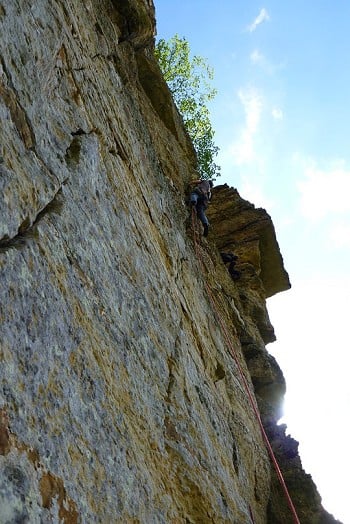
Black Mamba (E2 5b) E3 5b
If you're wanting an authentic Whitestone experience, away from the mostly solid right side of the cliff, Black Mamba offers 45 metres of snaking fist crack, bisecting the steepest reaches of the Black Mamba Cave with intimidating perfection. Best climbed in two pitches, the first section takes you to a comfortable stance right in the back of the cave. From here the gnarly start of the second pitch is visible and appears disconcertingly without an end. The climbing is typical of rough limestone cracks; a successful ascent demanding a good portion of the skin from the back of your hands. Despite the moves being highly absorbing, the position won't stop you from getting a distinctly Dolomite vibe and very quickly feels very scary. Every move takes you further up and further out, at the apex of the two vast flanks beside you. Fortunately, the gear is superb and as the final capping roof is encountered, a devious traverse line rightwards may be taken. Certainly not a route you'll forget in a hurry!
Jurassic Scarp (E3 5b) E3 5b
Perhaps slightly easier these days with the increase in the average climber's sport fitness, the last of the big walls on the right of Whitestone is a deserved pumpy classic. The route can just about be climbed in one pitch, with a straightforward bold lower section, feeling relaxingly slabby, but then being sharply interrupted by a decidedly steep upper wall. Chris Woodall's remarkable first ascent of this buttress was protected by pre-placed threads, which remain; the wall seemingly never having been done without them.
Peak Scar
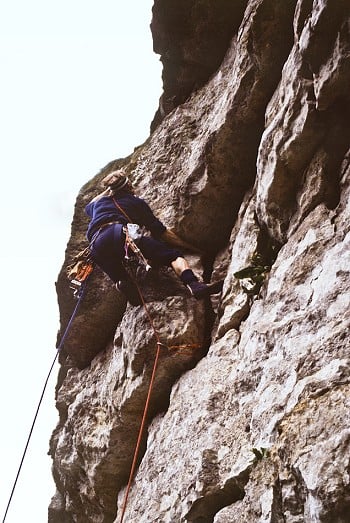
Following a fatality, the BMC agreed the following conditions with the landowner - failure to comply with these requirements could result in a complete ban on climbing:
- No large groups
- No outdoor education or instructional groups
- No dogs
- All climbers must descend on foot - NO abseiling
Jordu (S 4a) Severe
Jordu seems to capture the very essence of low-grade limestone climbing. A plumb vertical corner, the line manages to be both impressive and audacious, whilst still boasting plenty of relaxing positions to place good gear from and take in the view.
Frenesi (VS 4c) VS 4c
Peak Scar has several technical wall climbs to choose from; the best probably being the beautiful wall of Frenesi. This fine pitch takes a superb route up the most exposed buttress of the crag, quickly leaving the shintangled undergrowth for a much purer existence up high. Protection is never lacking, but several small bulges give the climbing an imposing feel. Once upon a time, it was traditional to split the climbing into a couple of pitches, but with careful ropework, it is now possible to enjoy the entirety of this mega classic in one spectacular pitch. Be sure to take a moment in the final cave to fully immerse yourself in the beauty of the wooded dale below.
![First free ascent of BBC [E2 5c], Originally required 4 pegs for aid. John Redhead climbing. 24th. September 1978. © Tony Marr](https://img.ukclimbing.com/i/211672?fm=jpg&time=1554985072&dpr=1&w=350&sharp=7&s=9557ee9eab0be6e002a14fd076b0fa87)
Quite at odds with the majority of the rest of the crag, BBC poses a wild athletic challenge through the large square overhang in the middle of the cliff. John Redhead's now famous first ascent of the line relied on only a couple of woefully poor pieces of gear, demanding both boldness and ingenuity in equal measure. These days the situation has changed very little; a largish cam or hex may protect the moves a little better, but the stiff pull through that obscenely exposed roof still packs a good adrenaline punch.
Bivvy E3 5c
This is one for the real limestone aficionados. Positioned at the extreme right end of the crag, back in the depths of the forest, this old school testpiece can now be protected with modern gear, as well as the old peg. Being the roof that once formed a popular bivvy spot for Teesside climbers in the '60s & '70s, the climbing is, as you'd imagine, unrelentingly steep. The moves haven't got any easier over the years, but some modern climbing wall power might just come in handy when pulling through the final reachy roof.
Ravenswick Quarry
The area surrounding Keldholme is littered with small crags and quarries, with the best of these being Ravenswick. Whilst the crag has been climbed on for decades, it has only been comprehensively recorded in recent years and the routes are yet to feature in a guidebook. The traditional routes are mostly sub-extreme and provide convenient top-roping off of trees and short leads on mostly solid rock, but the main interest lies in the bouldering and highballing in the right part of the quarry. With the crag being protected by tree cover, it can also provide an excellent option if rained off of the sandstone on Blakey Ridge. If you like Raventor bouldering, you'll love Ravenswick.
Logistics
When to Go
The Limestone season is quite different from that of the sandstone of the NY Moors. It is possible to find some enjoyable climbing for most of the year, as conditions at the two big crags are very different. Peak Scar is a superb summer venue, with it being sheltered by trees from the sun, wind and light rain. Its sheltered nature does render it slow to dry in winter, however, and the bottom of the crag can become very muddy after rain. Whitestone Cliffe, on the other hand, is a huge suntrap that can actually be quite unpleasant on a hot day from late afternoon onwards. The north-west facing central wall does remain slightly cooler than the rest of the crag, so if you're just after bagging the main classics, you might just survive without first degree burns. The reflective properties of this southwest-facing mirror have obvious benefits in the winter, when fine climbing may be enjoyed on even a coolish day, so long as the sun is shining and the wind is low. Of course, all limestone should be avoided when wet, as the cement that binds the rock together can weaken, making it dangerous to you and damaging to the climbs.
Gear
A pair of double ropes and a big rack comes recommended; particularly big nuts, cams and hexes. For classics such as The Nightwatch, take plenty of short and thin slings for threads. Abseiling is banned at Peak Scar due to a past accident, but an extra fixed rope at Whitestone can help with the descent, particularly in wet conditions. A helmet is certainly worth consideration in the event of anything becoming dislodged.
Outdoor Shops Advertise here
No Premier Listings found in this area
Accommodation Advertise here
No Premier Listings found in this area
As the furthest southwest of all the Moors crags, this area of limestone is very accessible for a day trip from Leeds, York or Sheffield. If you are coming from even further south, then there are many options for staying the night. Interestingly, as the underlying rock is limestone (and therefore better farming), the area has become much more affluent than the rest of the Moors and accommodation is on the swankier end of the spectrum. A personal favourite has to be The Star at Harome, which will do you a decent evening meal after a big day. The starters are particularly well put together, with exciting flavour combinations. It's a little pricy, but if you're coming from the south, you can probably afford it.
If you're looking for a cheaper alternative, there are several campsites around Helmsley, as well as B&Bs and pubs that often remain only partially occupied. A quick search on the internet will locate numerous options in the nearby area. Historically, people have stayed at Peak Scar (hence the name Bivvy (E3), but with the area not being access land and access being dependent on good relations with landowners, this is to be discouraged.
Guidebooks
Ravenswick is detailed in Betaguides' excellent North York Moors bouldering book, which also has more detail on the local area and how to get about. For details on the Trad routes, have a look at climbonline.co.uk or the UKC logbook pages, which have the most up to date information on new routes and approaches. All of these venues will be included in the coming North York Moors climbing guide, which will detail routes and bouldering alike.
Transport
It is worth having a car to access the limestone crags of the Moors, particularly if you are wanting to visit all of these crags (Ravenswick being positioned nearly 16 miles away from the other venues). It is possible to travel with relative ease by bus to Whitestone Cliffe from Pickering, as the top of the crag is also the Sutton Bank National Park Centre. Similarly, the Moors Bus may be taken to access Ravesnwick from this east-west line at Keldholme. Peak Scar is only a couple of miles from Whitestone, so it would be possible to walk or hitch in from there. Mobile phone signal can be fleeting in the area, so if travelling without a car, thorough preparation and a map may come in handy. Once at the parking locations of the crags, the walk-ins are all less than ten minutes.
- TRIP REPORT: Franco Cookson's Journey to the Mirror Wall 25 Dec, 2023
- ARTICLE: How to Become an E10 Climber 1 Apr, 2023
- OPINION: The Blurry Line - When does a sequence become a line? 9 Feb, 2022
- ARTICLE: 2021: The Year of the Headpoint 15 Nov, 2021
- ARTICLE: Franco Cookson's Guide to Headpointing 15 Jan, 2019
- DESTINATION GUIDE: Spittal Crag, Northumberland 16 Oct, 2018
- ARTICLE: Franco Cookson's Guide to Highballing 13 Jun, 2018
- DESTINATION GUIDE: The Yorkshire Coast 16 Apr, 2018
- DESTINATION GUIDE: North York Moors 15 May, 2008

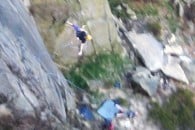

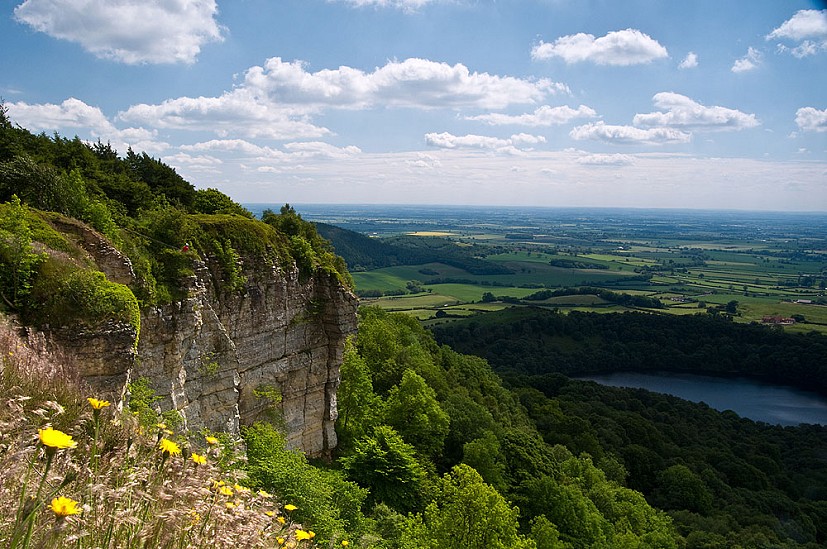

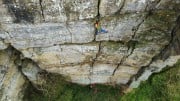

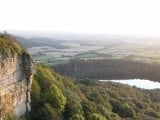

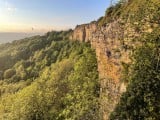


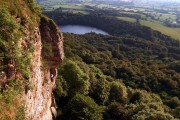
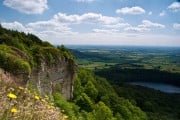

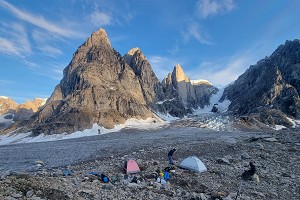
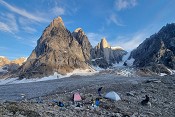





Comments
More articles like this please, climbing articles.
Happy to oblige!
We've just received a great (albeit esoteric) offering from Stu Bradbury on Cornish Off-widths, which should be a laugh. Besides that there's Chee Tor destination article I've been working on for several years (not because it's any good, more because I am - apparently - a very slow worker).
Sure Natalie has more in the pipeline, but there's a couple for starters :-)
Peak Scar is intimidating! I once figured if I could tick the HVSs there, I could climb E2 most other places... and wasn't wrong, though maybe that's more a reflection on my climbing style than the crag...
Cornish offwidths sounds awesome - really excited for that one!
It's by the same guy that wrote 'Hostile Terrain', which probably gives you a good flavour of what's in store. Got everything from Hard Severe up to in/around E5, so something for (nearly) everyone :-)
Having laid it all out yesterday it's looking amazing. I'm both inspired and intimidated...